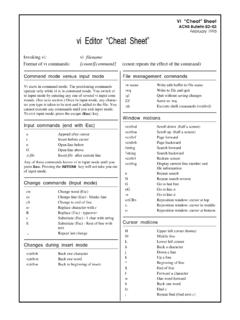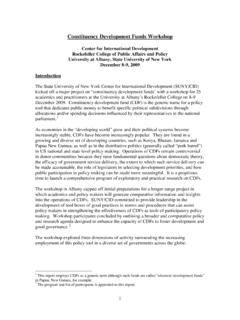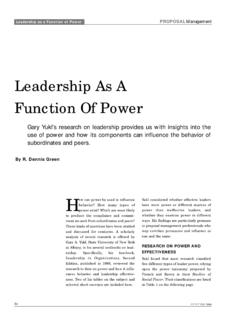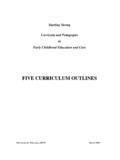Transcription of Discussion-Based Approaches to Developing …
1 Discussion-Based Approaches to Developing Understanding: Classroom Instructionand Student Performance in Middle and High School EnglishArthur N. Applebee; Judith A. Langer; Martin Nystrand; Adam GamoranAmerican Educational Research Journal, Vol. 40, No. 3. (Autumn, 2003), pp. URL: Educational Research Journalis currently published by American Educational Research use of the JSTOR archive indicates your acceptance of JSTOR's Terms and Conditions of Use, available JSTOR's Terms and Conditions of Use provides, in part, that unless you have obtainedprior permission, you may not download an entire issue of a journal or multiple copies of articles, and you may use content inthe JSTOR archive only for your personal.
2 Non-commercial contact the publisher regarding any further use of this work. Publisher contact information may be obtained copy of any part of a JSTOR transmission must contain the same copyright notice that appears on the screen or printedpage of such JSTOR Archive is a trusted digital repository providing for long-term preservation and access to leading academicjournals and scholarly literature from around the world. The Archive is supported by libraries, scholarly societies, publishers,and foundations.
3 It is an initiative of JSTOR, a not-for-profit organization with a mission to help the scholarly community takeadvantage of advances in technology. For more information regarding JSTOR, please contact Aug 15 12:13:37 2007 American Educational Research Journal Fall 2003, Vol. 40, NO. 3, pp. 685-730 Discussion-Based Approaches to Developing Understanding: Classroom Instruction and Student Performance in Middle and High School English Arthur N. Applebee and Judith A. Langer University at Albany Martin Nystrand and Adam Gamoran University of Wisconsin, Madison This study examines the relationships between student literacyperformance and Discussion-Based Approaches to the development of understanding in 64 middle and high school English classrooms.
4 A series of hierarchical linear models indicated that Discussion-Based Approaches were signijicantly related to spring performance, controlling for fall performance and other back- ground variables. These Approaches were effective across a range of situations and for low-achieving as well as high-achieving students, although interpre- tations are complicated because instruction is unequally distributed across tracks. Overall, the results suggest that students whose classroom literacy expe- riences emphasize Discussion-Based Approaches in the context of high aca- demic demands internalize the knowledge and skills necessa y to engage in challenging literacy tasks on their own.
5 KEYWORDS:classroom discourse, English language arts, instruction, literacy, secondary education. Since the early 1980s, many scholars who study the teaching of English and language arts have been engaged in an extended exploration of the nature of effective instruction. Often grounding their work in sociocognitivel theory about the nature of teaching and learning (Langer, 1985a), these researchers have drawn from disciplines ranging from anthropology (Heath, 1983) to psychology (Lee & Smagorinsky, 2000), to literary theory (Scholes, 19851, to linguistics (Cazden, 1979, 1988) in their efforts to understand the nature of classroom contexts that foster the development of higher levels of liter- acy among diverse groups of students.)
6 A variety of studies have examined what teachers know and how that relates to the instruction that they provide ( , Grossman, 1990); what students are actually asked to do in English lan- guage arts classes ( , Freedman, Simons, Kalnin, Casareno, & the M-Class Applebee et al. Teams, 1999); and how these activities influence what students learn ( , Hillocks, 1999). Our own research over the past 20 years has been part of this larger exploration of the nature of effective instruction. In separate studies, we have examined the teaching of writing (Applebee, 1981, 1984; Langer & Applebee, 1987; Nystrand, 1986; Nystrand, Gamoran, & Carbonaro, 2001); the relationship between writing and reading (Langer, 1986); the teaching of literature (Applebee, 1993; Langer, 1995; Nystrand, 1997; Nystrand & Gamoran, 1991); the structure of curriculum (Applebee, 1996); the effects of tracking on achievement and equality of opportunity (Gamoran, Nystrand, Berends, & LePore, 1995).
7 And the roles of teachers and students in effective classroom interaction (Langer, 1995, 2001, 2002; Nystrand, 1997). In the present study, we sought to take work in this area further by explicating commonalities among our previous findings and those of other researchers who share a focus on the importance of Discussion-Based Approaches in teaching for in-depth understanding (Bransford, Brown, & Cocking, 1999). We sought to use those commonalities as a base from which to examine whether classrooms that emphasize such Approaches are more successful than other classrooms in improving students' literacy performance.
8 In a field where much of the research, including much of our own, has relied on case study methodologies and descriptive analyses, an additional goal was to examine how findings from previous work would hold up when examined in a relatively large-scale quantitative study, in a broad spectrum of middle and high school classrooms. In the sections that follow, we dis- cuss the results of previous work and then examine literacy performance at the end of an academic year (controlling for initial performance) among mid- dle and high school students whose classrooms varied in ways that earlier studies have suggested are related to performance differences.
9 ARTHCRN. APPLEBEE is a Professor of Education at the University at Albany, State University of New York, 1400 Washington Avenue, Albany, NY 12222; e-mail area of specialization is the intersection of lan- guage and learning, particularly in the teaching of English language arts. JUDITH A. LANCERis a Distinguished Professor at the University at Albany, State University of New York, 1400 Washington Avenue, Albany, NY 12222; e-mail jlange~ specializes in research in literacy development and instruction.
10 MAR~N is a Professor of English at the University of Wisconsin, Madison, NYSTRAP~D 600 N. Park Street, Madison, WI 53706; e-mail research examines the role of discourse, in both writing and classroom interaction, in English language arts instruction and learning. ADAMGAVORANis a Professor of Sociology and Educational Policy Studies at the University of Wisconsin, Madison, 1180 Observatory Drive, Madison, WI 53706; e-mail research focuses on inequality in educational achievement and the organizational context of school reform.















